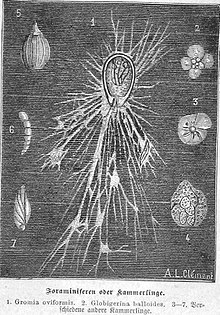网足虫属
| 网足虫属 | |
|---|---|

| |
| 网足虫(1)与其他有孔虫界的生物(2-7) | |
| 科学分类 | |
| 门: | 变形虫门 Amoebozoa |
| 纲: | 根足纲 Rhizopodea |
| 目: | 无壳目 Aconchulinida |
| 科: | 网虫足科 Gromiidae |
| 属: | 网足虫属 Gromia Dujardin, 1835 |
| 异名 | |
| |
网足虫属(学名:Gromia)是丝足虫门的一个属,为单细胞生物,栖息在淡水或海水中,本属生物形似变形虫,有一蛋白质组成的蜂窝状壳体将细胞质包覆,并有许多伪足从壳体表面的孔洞中伸出,可互相交连形成网状结构[1],用以爬行移动[2]。本属物种的直径介于0.4-30毫米间,细胞质中具有Stercomata(排泄物)与矿物颗粒[3],壳体形状多变,有球型者(G. oviformis),也有梨形者(G. pyriforminis),常作为本属物种的分类依据。本属生物可行无性生殖与有性生殖[4]。
本属最早被发现的物种为G. oviformis,于1835年在英国海边的潮间带被发现[5],1990年代起开始有多种深海中的网足虫被发现,包括生存在4392米深处者[3],深海的网足虫可能在碳循环[3] 与氮循环(反硝化反应)[6]中扮演一定角色。有研究显示本属的一深海物种圆球网足虫可在海床上留下爬痕,与复杂多细胞动物所留下的遗迹化石类似,使考古学家怀疑此类化石是否能当作多细胞动物存在的依据[7] 。
下属物种[编辑]
本属包括以下物种:[8]
- Gromia amygdaliformis Gooday & Holzmann, 2022
- Gromia appendiculariae Brooks & Kellner, 1908
- Gromia botelliformis Gooday & Holzmann, 2021
- 短网足虫 Gromia brevis Gooday & Holzmann, 2021
- Gromia cedhageni Gooday & Holzmann, 2022
- Gromia cucumiformis Gooday & Holzmann, 2021
- Gromia dubia Gruber, 1884
- Gromia dujardinii Schultze, 1854
- Gromia fluvialis Dujardin, 1837
- Gromia granulata Schulze, 1875
- Gromia hyalina Schlumberger, 1845
- Gromia landrethi Gooday & Holzmann, 2022
- Gromia liasica Terquem, 1866
- Gromia marmorea Rothe, Gooday, Cedhagen, Fahrni, Hughes, Page, Pearce & Pawlowski, 2009
- Gromia melinus Rothe, Gooday, Cedhagen, Fahrni, Hughes, Page, Pearce & Pawlowski, 2009
- Gromia oviformis Dujardin, 1835
- Gromia pashukae Gooday & Holzmann, 2022
- Gromia psammophila Gooday & Holzmann, 2022
- Gromia pyriformis Gooday & Bowser, 2005
- Gromia saoirsei Gooday & Holzmann, 2022
- Gromia schulzei Norman, 1892
- Gromia solenopus Zarnik, 1907
- 圆球网足虫 Gromia sphaerica Gooday, Bowser, Bett & Smith, 2000
- Gromia winnetoui Rothe, Gooday, Cedhagen, Fahrni, Hughes, Page, Pearce & Pawlowski, 2009
参考文献[编辑]
- ^ Longet, D., Burki, F., Flakowski, J., Berney, C., Polet, S., Fahrni, J., & Pawlowski, J. (2004). Multigene evidence for close evolutionary relations between Gromia and foraminifera. Acta Protozoologica, 43(4), 303–311.
- ^ Matz, M. V., Frank, T. M., Marshall, N. J., Widder, E. A., & Johnsen, S. (2008). Giant Deep-Sea Protist Produces Bilaterian-like Traces. Current Biology, 18(23), 1849–1854. https://doi.org/10.1016/j.cub.2008.10.028
- ^ 3.0 3.1 3.2 Rothe, N., Gooday, A. J., Cedhagen, T., & Alan Hughes, J. (2011). Biodiversity and distribution of the genus Gromia (Protista, Rhizaria) in the deep Weddell Sea (Southern Ocean). Polar Biology, 34(1), 69–81. https://doi.org/10.1007/s00300-010-0859-z
- ^ ARNOLD, Z. M. (1966). Observations on the Sexual Generation of Gromia oviformis Dujardin. The Journal of Protozoology, 13(1), 23–27. https://doi.org/10.1111/j.1550-7408.1966.tb01863.x
- ^ Hayward, B. W., Le Coze, F., & Gross, O. (2018). World Foraminifera Database. Gromia Dujardin. Retrieved February 26, 2020, from http://www.marinespecies.org/foraminifera/aphia.php?p=taxdetails&id=111984 (页面存档备份,存于互联网档案馆)
- ^ Høgslund, S., Cedhagen, T., Bowser, S. S., & Risgaard-Petersen, N. (2017). Sinks and Sources of Intracellular Nitrate in Gromiids. Frontiers in Microbiology, 8(APR), 617. https://doi.org/10.3389/fmicb.2017.00617
- ^ Matz, M. V., Frank, T. M., Marshall, N. J., Widder, E. A., & Johnsen, S. (2008). Giant Deep-Sea Protist Produces Bilaterian-like Traces. Current Biology, 18(23), 1849–1854. https://doi.org/10.1016/j.cub.2008.10.028
- ^ Gromia Dujardin, 1835. GBIF. [2023-01-16]. (原始内容存档于2023-01-16).
| ||||||||||||||||||||||||||||||||||||||||||||||||||||||||||||||||||||||||||||||||||||
|
